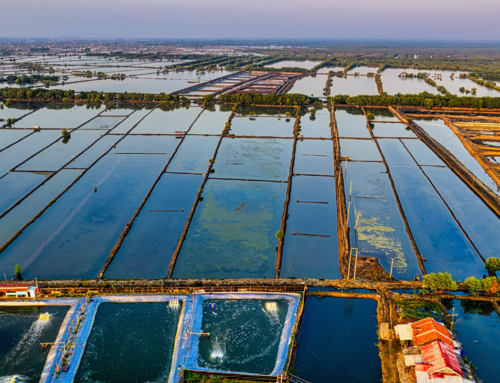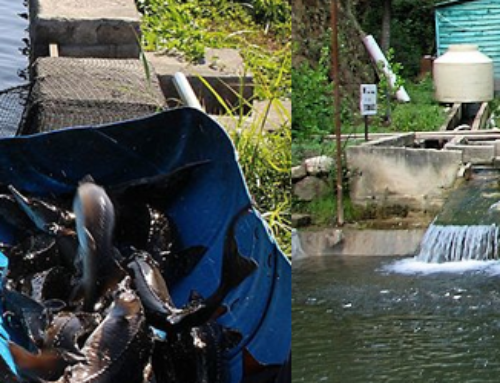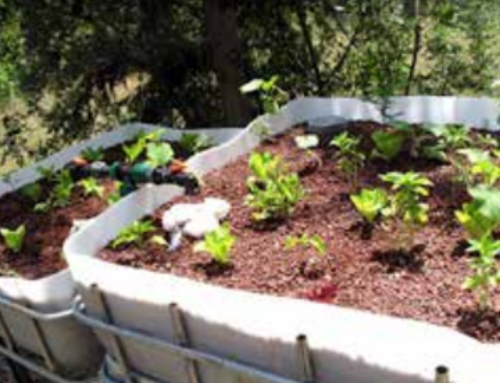Biofiters main nitrifying bacteria
Aquaponics relies heavily on the work of nitrifying bacteria in order to prevent fish waste from reaching toxic levels. Bacteria, therefore, forms a vital link between the components of the aquaponic ecosystem, making it possible for plants to effectively filter water in the system.
There are three main groups of bacteria which are necessary for the functioning of an aquaponic system, and which are often referred to as the “biofilter”:
- Ammonia-oxidizing bacteria, converting toxic ammonia into nitrites;
- Nitrite-oxidizing bacteria, which convert nitrites into nitrates, the most available form of nutrients for plants;
- Heterotrophic bacteria, which break down solid fish and plant wastes into available micro-nutrients, which are also necessary for plant growth.
Our main focus is the bacteria which deal with ammonia and nitrogen. The first two bacteria are referred to together as nitrifying bacteria and are the difference between the life and death of an aquaponic system.
Without nitrifying bacteria, systems will quickly become toxic, resulting in mass fish deaths.
Additionally, healthy colonies of nitrifying and heterotrophic bacteria prevent the growth of less beneficial bacteria, which may infect plants or fish, and cause harm to the system, upsetting the vital balance of the system components.
How to Grow Nitrifying Bacteria?
It is very important to create an environment in your aquaponic system which is bacteria-friendly and will encourage the growth of a healthy bacterial colony.
Environmental requirements
Both nitrifying and heterotrophic bacteria require the following elements.
- Water temperature 60-85F (15-30C)
- Water pH of 6-7.5
- Protection from sunlight (UV light)
- High oxygen levels
An additional advantage of providing an oxygen-rich environment is that it is disliked by the majority of unwanted bacteria which might otherwise colonize an aquaponic system, such as denitrifying bacteria and sulfate-reducing bacteria, both of which can create system conditions toxic to fish.
Biofilter requirements
A biofilter is a large tank which is intended to house the nitrifying bacteria in an aquaponic unit (heterotrophic bacteria will naturally colonize any areas where solid waste is found, such as the bottom of fish tanks, filters and grow beds).
- A biofilter should provide the ideal habitat for nitrifying bacteria, so must be opaque and covered, in order to protect bacteria from sunlight.
- Biofilters should also be well-aerated, and it is not uncommon to situate an air-stone within.
Nitrifying bacteria will grow on any wet surface, so the primary purpose of a biofilter is to provide a large amount of surface area for the bacteria to colonize. This might comprise a tank filled with one of the aforementioned growing media (porous volcanic stone or expanded clay beads work particularly well), with weighted plastic or Styrofoam packing beads (large enough not to clog filters or enter the system), commercially produced “Bio-filter Balls” or even with bundles of a large-gauge plastic fencing or net material. Any material which provides space for bacteria colonies to grow will work.
Sourcing bacteria
Heterotrophic bacteria exist naturally everywhere and will populate a new aquaponic unit in sufficient numbers that sourcing them is unnecessary.
Nitrifying bacteria also exist naturally in water and air and will colonize a new aquaponic unit unassisted once system cycling is begun. However, many new aquaponic growers source nitrifying bacteria externally. Keep in mind that bacteria colonies are not made, they grow. Therefore, sourcing nitrifying bacteria externally merely hastens the process of system cycling somewhat, it does not negate it.
Nitrifying bacteria can be sourced in two ways:
1. Aquaponic, aquaculture and aquarium stores sell various “liquid” forms of nitrifying bacteria.
2. Water or biofilter material from a mature and balanced aquaponic system (make sure is disease free), or even an aquarium, can be used as a source of nitrifying bacteria.
System Cycling
System cycling is the process of establishing a colony of nitrifying bacteria in an aquaponic unit. Even if bacteria are sourced from an aquaponics store or existing system, cycling will still be necessary in order to allow bacteria to colonize the new system in sufficient numbers to support fish.
Nitrifying bacteria reproduce relatively slowly, and therefore the process of system cycling can take anywhere between 2 weeks and 2 months, depending on the initial source of bacteria and environmental conditions such as temperature.
Adding fish before the system cycling is complete, due to insufficient nitrifying bacteria to process all of their waste, these fish will likely die and those that survive will be sickly and stunted from exposure to high levels of ammonia and nitrite.
System cycling consists of gradually adding ammonia to a new aquaponic unit. The system is run, or the water cycled, as if the unit was complete and producing, even though there are no plants or fish. The addition of ammonia provides a food source for the nitrifying bacteria and encourages the establishment of a biofilter colony.
Sources of ammonia for system cycling
Various sources of ammonia can be used for system cycling. Options include the following.
1- Pure ammonia
In some countries, it is possible to purchase ammonia at hardware or chemists. Ammonia may also be available as a cleaner and can be used to system cycle provided it does not contain colorants, scents or other additives.
2- Fish food
Fresh fish food ground to a fine powder is an inexpensive ammonia source for cycling.
3- Biological sources
Animal manures and aged urine can be used as an ammonia source but should be sterilized to ensure that unwanted bacteria and pathogens are not introduced to the system.
4- Fish
Fish stocked at an extremely low density – 1-2 per 9 cubic feet (1-2 per m3) – can be used as an initial source of ammonia.
How to system cycle
Once the aquaponic unit is running and water flow is established, a small amount of ammonia is added to the system each day. This ammonia provides a constant food source for the nitrifying bacteria and encourages reproduction and the establishment of colonies.
When adding ammonia initially, the goal is to establish and maintain a system-wide ammonia level of less than a two-hundredth of a percent (0.005%).
Levels significantly higher than this will be toxic even to nitrifying bacteria and require the immediate dilution of water in the system.
Note that ammonia is available in different strengths, so the amount added to the system will depend on the water volume of your unit as well as the concentration of your ammonia source. The following equation can be used to calculate the amount of ammonia to be added daily:

 In a cycling system, ammonia-oxidizing bacteria will colonize the biofilter in the first week, causing an increase of nitrite in the water. After another week or so, the system will show both nitrites and nitrates, as colonies of nitrite-oxidizing bacteria become established.
In a cycling system, ammonia-oxidizing bacteria will colonize the biofilter in the first week, causing an increase of nitrite in the water. After another week or so, the system will show both nitrites and nitrates, as colonies of nitrite-oxidizing bacteria become established.
When the system has ammonia and nitrite levels of less than 0.00005 ounces per quart (1-2 mg per liter) – essentially, ammonia levels so low as to be immeasurable – the system cycling process is complete. Bacteria colonies are established and the system is ready for the addition of plants and fish.
Adding plants and fish
Although they are unlikely to thrive, plants can be added to an aquaponic system prior to the end of system cycling. Fish, on the other hand, should only be added once cycling is complete.
If you have completed the system cycling process but are not yet ready to add fish, a stable level of ammonia should be added to the system daily as when cycling. If this is neglected, your painstakingly cultivated bacteria colonies will quickly starve to death and you will have to begin the process again.
Fish should be added gradually to a new aquaponic unit, a couple at a time. Even in small numbers, fish are likely to produce more ammonia than the bacteria colonies are accustomed to processing. It will make the system a few days to re-establish equilibrium and bring ammonia and nitrite levels back to below 0.00005 ounces per quarter (1mg per liter) once of fish that have been added.
Monitoring bacteria
Although a brownish slime in the biofilter or on other system surfaces is indicative of nitrifying bacteria, it is impossible to actually measure the population of the colonies successfully on a home scale. Instead, bacteria are monitored through measurements of ammonia, nitrites, and nitrates.
Nitrites and nitrates will only be present in an aquaponic system through the functioning of nitrifying bacteria, and if a stable ammonia and nitrite level of below 0.00005 ounces per quart (1mg per liter) is maintained, it can be safely assumed that the bacteria in your system is healthy and happy.
What you have to test frequently:
Water Temperature, Water PH, Dissolved Oxygen, CO2 level, Electrical Conductivity (EC), Ammonia, Nitrite, Nitrate, Water Hardness, Iron.
Aquaponics Monitoring System: Test Kit and pH
Ingredients of a commercial biofilter starter.
AQUAVIVE contains a synergistic blend of all-natural, non-Genetically Modified (non-GMO) species of safe and beneficial microorganisms.
| Bacillus subtilis
Bacillus subtilis can use nitrite or nitrate as a terminal acceptor of electrons. Bacillus subtilis contains two unique nitrate reductases. One is used for nitrate nitrogen assimilation and the other is used for nitrate respiration. |
5 x 108 CFU/g |
| Bacillus coagulans
Bacillus coagulans is a type of good bacteria, called a probiotic. It produces lactic acid, but isn’t the same thing as Lactobacillus, another type of probiotic. |
5 x 108 CFU/g |
| Bacillus pumilus
Bacillus pumilus is a spore-forming bacteria that is rod-shaped, Gram-positive, and aerobic. It resides in soils and some colonize in the root area of some plants where B. pumilus has antibacterial and antifungal activity. |
5 x 108 CFU/g |
| Bacillus licheniformis
It produces a variety of extracellular enzymes that are associated with the cycling of nutrients in nature. |
5 x 108 CFU/g |
| Bacillus polymyxa
Bacillus polymyxa, is a Gram-positive bacterium capable of fixing nitrogen. It is found in soil, plant tissues and marine sediments. |
5 x 108 CFU/g |
| Bacillus amyloliquefaciens
Bacillus amyloliquefaciens is a species of bacterium in the genus Bacillus that is the source of the BamHI restriction enzyme. |
5 x 108 CFU/g |
| Dendrite salt
Its unique and diverse physical properties result in low bulk density, a rapid dissolving rate, exceptional flow characteristics, strong blend ability, unmatched liquid adsorption and a quick, salty sensation. |
90% |
| Dextrose
Dextrose is a type of simple sugar made from corn. It is similar to fructose and chemically identical to glucose, which is blood sugar. Simple sugars, including dextrose, fructose, and glucose |
5% |





Leave A Comment
You must be logged in to post a comment.